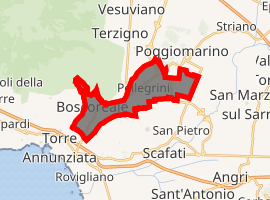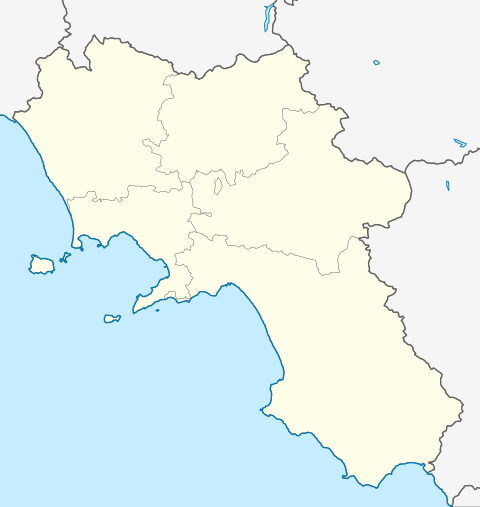Boscoreale
Boscoreale (Italian pronunciation: [boskoreˈaːle]) is an Italian comune and town in the Metropolitan City of Naples, Campania, with a population of 27,457 in 2011.[2] Located in the Parco Nazionale del Vesuvio, under the slopes of Mount Vesuvius, it is known for the fruit and vineyards of Lacryma Christi del Vesuvio. There is also a fine Vesuvian lava stone production.
Boscoreale | |
|---|---|
 Municipal park | |
 Coat of arms | |
Location of Boscoreale 
| |
 Boscoreale Location of Boscoreale in Italy  Boscoreale Boscoreale (Campania) | |
| Coordinates: 40°46′N 14°29′E | |
| Country | Italy |
| Region | Campania |
| Metropolitan city | Naples (NA) |
| Frazioni | Cangiani, Marchesa, Marra, Passanti, Pellegrini |
| Government | |
| • Mayor | Giuseppe Balzano |
| Area | |
| • Total | 11.28 km2 (4.36 sq mi) |
| Elevation | 65 m (213 ft) |
| Population (30 September 2015)[2] | |
| • Total | 28,066 |
| • Density | 2,500/km2 (6,400/sq mi) |
| Demonym(s) | Boschesi |
| Time zone | UTC+1 (CET) |
| • Summer (DST) | UTC+2 (CEST) |
| Postal code | 80041 |
| Dialing code | 081 |
| Saint day | 16 July |
| Website | Official website |
History

The neighbourhood of Monte Bursaccio which was overcome by the eruption of Vesuvius in 79 AD that obliterated and preserved its better-known neighbours, Pompeii and Herculaneum, is famous for the frescoes of its aristocratic villas, excavated before World War I. A hoard of Roman silver and coins that had been hurriedly stashed in a cistern for protection at the time of the eruption was also recovered in Boscoreale in 1895, and divided among several museums, including the Louvre and the British Museum.
Boscoreale, about a kilometre north of Pompeii of which it was an expansive, more rural outlying suburb, was notable in antiquity for having numerous aristocratic country villas and was preserved as a hunting park - hence its name, meaning "Royal Grove" - by the kings of Naples.
The villa of P. Fannius Synistor (see Villa Boscoreale) was built and decorated shortly after mid-first century BC. The quality of its frescoes seems to have preserved them from changes in fashion, before the villa was entombed in the eruption.
The Antiquarium of Boscoreale was founded in 1991 by the Soprintendenza archeologica di Pompei thanks to the finds from Pompeii, Herculaneum, Oplontis, Stabiae, Terzigno, and Boscoreale and to a didactic apparatus.
The neighbouring Boscotrecase yielded some elite works of art to excavators at the same time, in particular at the Villa of Agrippa Postumus, also known as the Imperial Villa or the Villa of Augusta.
Geography
The municipality is part of Naples metropolitan area, and borders with Boscotrecase, Poggiomarino, Pompei, Scafati (SA), Terzigno, and Torre Annunziata. It counts the hamlets (frazioni) of Cangiani, Marchesa, Marra, Passanti, and Pellegrini.
See also
References
- "Superficie di Comuni Province e Regioni italiane al 9 ottobre 2011". Istat. Retrieved 16 March 2019.
- (in Italian) Source: Istat 2011
- British Museum Collection
Sources
- Baratte, François (1986). Le Trésor d'orfèvrerie romaine de Boscoreale. Paris: Musée de Louvre. ISBN 2-7118-2048-3.
External links
| Wikimedia Commons has media related to Boscoreale. |
- (in Italian) Official website
- (in Italian) Boscoreale on comuni-italiani.it
- Soprintendenza Archeologica di Pompeii: the main rustic villas
- Herculaneum/Pompeii/Stabiae website
- AD79 Year of Destruction Website
- Frescos from the house of P. Fannius Synistor, Boscoreale (Metropolitan Museum of Art)
- Fresco section from the villa of Fannius Sinistor, Boscoreale (Archaeological Museum Naples
- Cubiculum from the house of P. Fannius Synistor, Boscoreale (Metropolitan Museum of Art)
- Period Rooms in the Metropolitan Museum of Art (fully digitized text from The Metropolitan Museum of Art Libraries)
- Boscoreale treasure (Musée du Louvre)
